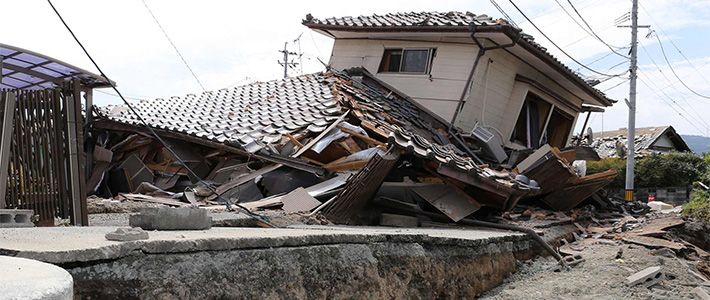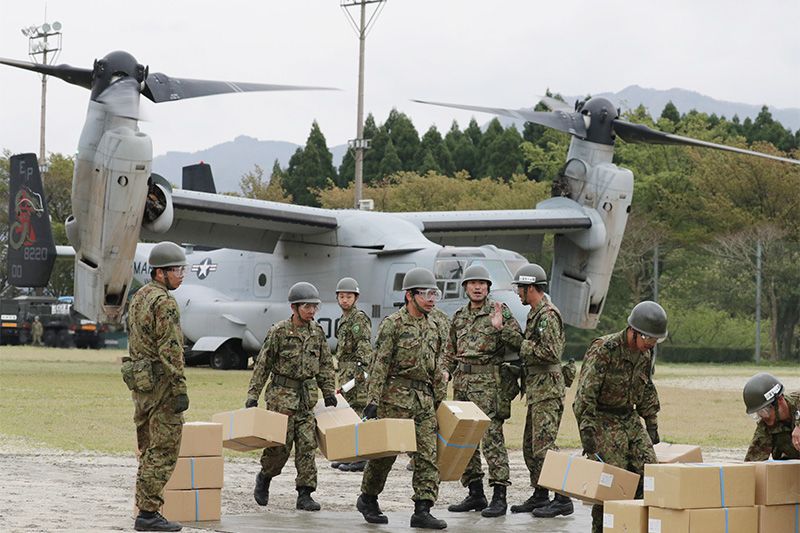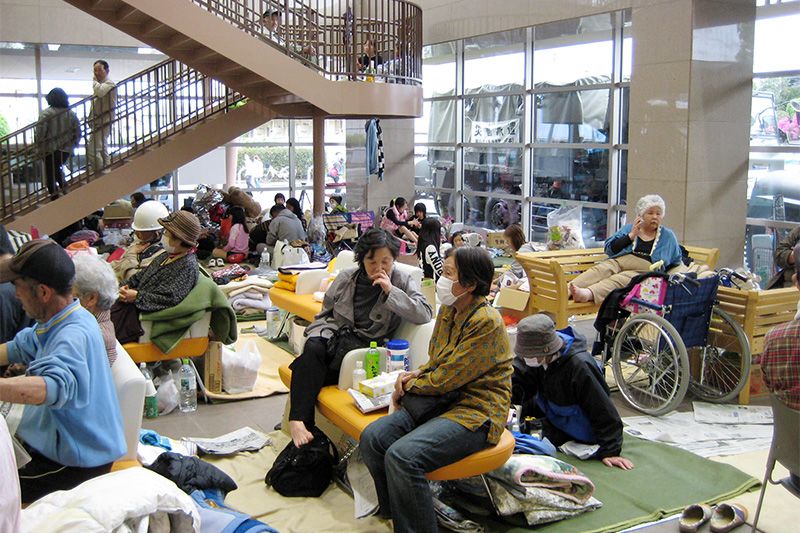
Evacuees Fill Shelters as Toll of Kumamoto Quakes Climbs
Society- English
- 日本語
- 简体字
- 繁體字
- Français
- Español
- العربية
- Русский
Rescue and relief efforts continue as residents mark a week since a string of large earthquakes began rocking Kumamoto and Ōita Prefectures. A magnitude 6.5 foreshock struck April 14, followed by the M7.3 main quake, centered in Mashiki, on April 16. Perceptible aftershocks have continued at a rate of 70–80 per day, taking an emotional toll on residents. More than 90,000 people have fled their homes, raising health concerns stemming from the long-term stress of living in cramped conditions at shelters and other temporary accommodations. Elderly evacuees are particularly at risk, with a growing number of disaster-related deaths being reported. And heavy rain has increased the risk of landslides, hampering the search for victims.
Death Toll Still Climbing
According to Kumamoto government figures from April 20, the quakes have killed 48 people, with 3 others missing and thought to be victims of landslides. Assessment of destruction is still ongoing, but authorities estimate the tremors damaged 8,600 homes, with approximately 1,500 of these totally destroyed.
Quake Effects in Kumamoto Prefecture (as of April 20)
| Earthquake fatalities | 48 |
| Disaster-related deaths | 11 |
| Missing | 3 |
| Injured | 1,153 (210 seriously) |
| Evacuation shelters | 623 |
| Evacuees | 92,314 |
| Homes | Destroyed 1,484 |
| Partially destroyed 1,324 | |
| Total damaged 8,600 (estimate) | |
| Households without tap water | 98,400 |
Source: Kumamoto Prefecture
As of April 20, authorities have dispatched approximately 2,000 disaster relief personnel from outside the prefecture to affected areas, along with 24,000 Self-Defense Force troops and 125 aircraft to transport water, food, and other relief goods to quake victims.
 Self-Defense Force troops unload relief supplies from a US military MV-22 Osprey in Minamiaso, Kumamoto Prefecture, on April 18, 2016. (© Jiji)
Self-Defense Force troops unload relief supplies from a US military MV-22 Osprey in Minamiaso, Kumamoto Prefecture, on April 18, 2016. (© Jiji)
No Reduction in Evacuee Numbers
The Japan Meteorological Agency upgraded the shaking from the April 16 earthquake to 7, the highest level on the Japanese seismic intensity scale, in the town of Mashiki and the village of Nishihara. This put it on parity with the April 14 tremor, which caused intensity 7 shaking in Mashiki. The level of shaking was equal to that felt in Kurihara, Miyagi Prefecture in the 2011 Great East Japan Earthquake and marks the first time since records have been kept that multiple quakes linked to the same event have created such powerful seismic movement.
Ongoing aftershocks have rattled disasters areas, with over 700 recorded as of April 20. A JMA official during a press conference earlier in the week explained that experts are at a loss to know when the rumbling will abate.
Number and Seismic Intensity of Quakes
| 14-Apr | 15 | 16 | 17 | 18 | 19 | 20 | |
|---|---|---|---|---|---|---|---|
| Seismic intensity 1 | 12 | 30 | 20 | 29 | 19 | 24 | 18 |
| 2 | 10 | 51 | 70 | 70 | 33 | 33 | 40 |
| 3 | 6 | 19 | 67 | 28 | 22 | 20 | 15 |
| 4 | 9 | 10 | 36 | 11 | 4 | 2 | 1 |
| Lower 5 | 1 | 1 | 4 | 0 | 0 | 1 | 0 |
| Upper 5 | 0 | 0 | 1 | 0 | 1 | 1 | 0 |
| Lower 6 | 1 | 0 | 2 | 0 | 0 | 0 | 0 |
| Upper 6 | 0 | 1 | 1 | 0 | 0 | 0 | 0 |
| 7 | 1 | 0 | 1 | 0 | 0 | 0 | 0 |
| Total by day | 40 | 112 | 202 | 138 | 79 | 81 | 74 |
| Total | 40 | 152 | 354 | 492 | 571 | 652 | 726 |
Constant aftershocks and close to 100,000 homes without running water have forced over 90,000 residents to seek refuge at emergency shelters and other areas. Many evacuees are sleeping in parks or in their cars, citing a lack of privacy and concerns about caring for small children among their reasons for not wanting to stay in cramped evacuation facilities.
 Evacuees shelter at an elderly care facility in Mashiki, Kumamoto Prefecture, on April 18, 2016. (© Jiji)
Evacuees shelter at an elderly care facility in Mashiki, Kumamoto Prefecture, on April 18, 2016. (© Jiji)
Quake-Related Deaths on the Rise
As authorities scramble to respond to the needs of residents, a new concern over the health of evacuees, in particular the elderly, has emerged. As of April 20, 11 quake-related deaths in Kumamoto thought to be due to the fatigue and stress of living in emergency shelters have been reported.
With so many residents living in cars, relief workers are concerned over a potential increase in cases of pulmonary embolism, commonly known as “economy class syndrome,” with at least one death already confirmed. A medical relief worker cited poor access to toilets in evacuation areas as a possible risk factor, saying, “People tend to cut back on their water intake [to avoid having to use restrooms frequently], which can lead to a number of health problems.” Volunteers in Mashiki and other quake-effected areas are actively approaching residents living in their cars to make them aware of potential risks.
Lifelines Gradually Being Restored
Power has largely been restored across Kumamoto, while gas, water, and mobile phone services are slowly coming back on line in certain areas.
Workers have gradually opened transportation routes in and out of disaster areas, but a number of highways running through Kumamoto remain closed to traffic. A bus service linking Kumamoto with neighboring Fukuoka opened on April 21, helping ease access. Parts of Kumamoto Airport, which was heavily damaged in the tremors, have opened, but the Kyūshū Shinkansen remains stopped between Hakata and Shin-Minamata Stations due to a derailed train and track damage. JR Kyūshū said it is not sure when services will resume.
(Banner photo: The wreckage of a home in Mashiki, Kumamoto Prefecture, following a pre-dawn earthquake on April 16, 2016. © Jiji.)